Lalique Group Bundle
How did Lalique Group Transform from Art to Luxury?
Journey into the captivating Lalique Group SWOT Analysis and discover the evolution of a brand that began with René Lalique's artistry. From its Parisian origins in 1888, Lalique has redefined luxury, blending artistic vision with innovative techniques. This brief history unveils the transformation of Lalique from a jewelry and glass workshop into a global luxury powerhouse.
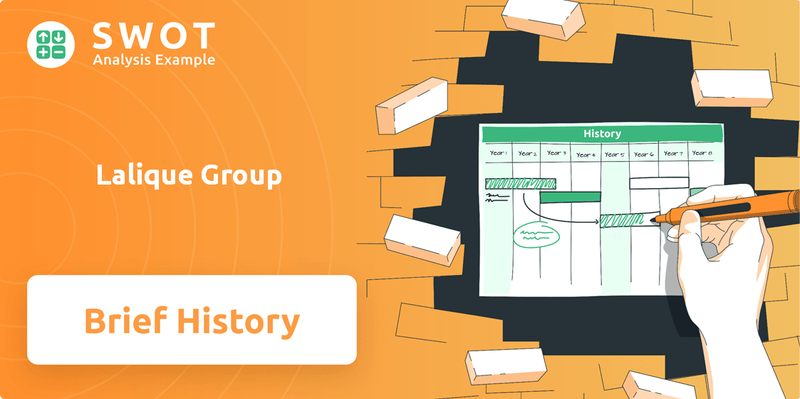
The Lalique history is a testament to the enduring power of design and strategic adaptation. Explore the legacy of René Lalique, the founder, and how his vision shaped the Lalique company. Discover the expansion from exquisite Lalique crystal to a diverse portfolio including Lalique perfume and other luxury goods, solidifying its position in the market.
What is the Lalique Group Founding Story?
The Lalique Group, a name synonymous with luxury and artistic craftsmanship, traces its origins back to the late 19th century. The founding story of the Lalique Group is deeply intertwined with the vision of its founder, René Lalique, a master jeweler and artist whose innovative approach redefined the world of luxury goods.
René Lalique's journey began in 1888, marking the birth of what would become a globally recognized brand. His early work, characterized by the use of unconventional materials like glass and enamel, set him apart from his contemporaries. This pioneering spirit laid the foundation for the company's future, influencing its artistic direction and its commitment to quality.
René Lalique, born in 1860 in Ay, Marne, France, identified a problem in the rigid traditionalism of 19th-century jewelry design. He sought to create pieces where artistic expression took precedence over the intrinsic value of materials. His initial business model centered on crafting unique, high-quality jewelry that prioritized design and craftsmanship. The cultural context of the Art Nouveau movement heavily influenced his creations.
René Lalique founded the company in 1888, initially focusing on high-quality jewelry.
- René Lalique studied at the École des Arts Décoratifs in Paris and Sydenham Art College in London.
- Early jewelry designs featured naturalistic motifs and incorporated glass and enamel.
- The shift to glassmaking in the early 20th century was a strategic pivot.
- Initial funding came from successful jewelry commissions and personal capital.
- The Art Nouveau movement significantly influenced Lalique's artistic direction.
Lalique Group SWOT Analysis
- Complete SWOT Breakdown
- Fully Customizable
- Editable in Excel & Word
- Professional Formatting
- Investor-Ready Format
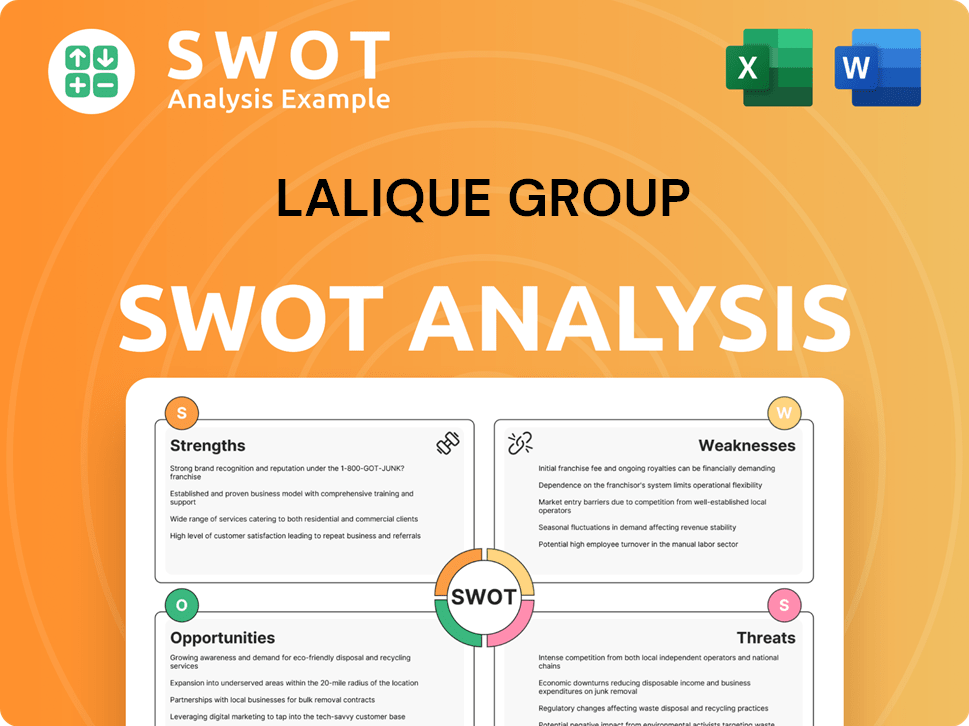
What Drove the Early Growth of Lalique Group?
The early growth of the Lalique Group company, formerly known as Lalique, was defined by René Lalique's transition from a celebrated jeweler to a master glassmaker. This period saw the introduction of iconic glass creations, including perfume bottles, vases, and decorative objects, all showcasing his innovative techniques and artistic vision. Early collaborations with perfumers like François Coty were pivotal, revolutionizing the packaging industry. These partnerships significantly boosted the company's recognition, cementing Lalique's reputation for artistic glass.
René Lalique's early work focused on glass, moving away from jewelry. His innovative techniques and artistic vision set the stage for the company's future. The launch of perfume bottles, vases, and decorative objects marked a significant shift in the luxury goods market.
Collaborations with perfumers, particularly François Coty, were crucial. These partnerships led to the creation of exquisite perfume bottles. The collaborations brought widespread recognition and solidified the company's reputation.
The company expanded its production capabilities, establishing glassworks in Combs-la-Ville in 1909. The larger Wingen-sur-Moder factory in Alsace, established in 1921, remains the sole manufacturing site. This expansion allowed for increased production and diversification.
The 1920s, influenced by the Art Deco movement, saw Lalique's designs evolve. The designs incorporated more geometric forms while maintaining their elegance. International exhibitions played a key role in gaining a global clientele. For more information on the Target Market of Lalique Group, read the article.
Lalique Group PESTLE Analysis
- Covers All 6 PESTLE Categories
- No Research Needed – Save Hours of Work
- Built by Experts, Trusted by Consultants
- Instant Download, Ready to Use
- 100% Editable, Fully Customizable
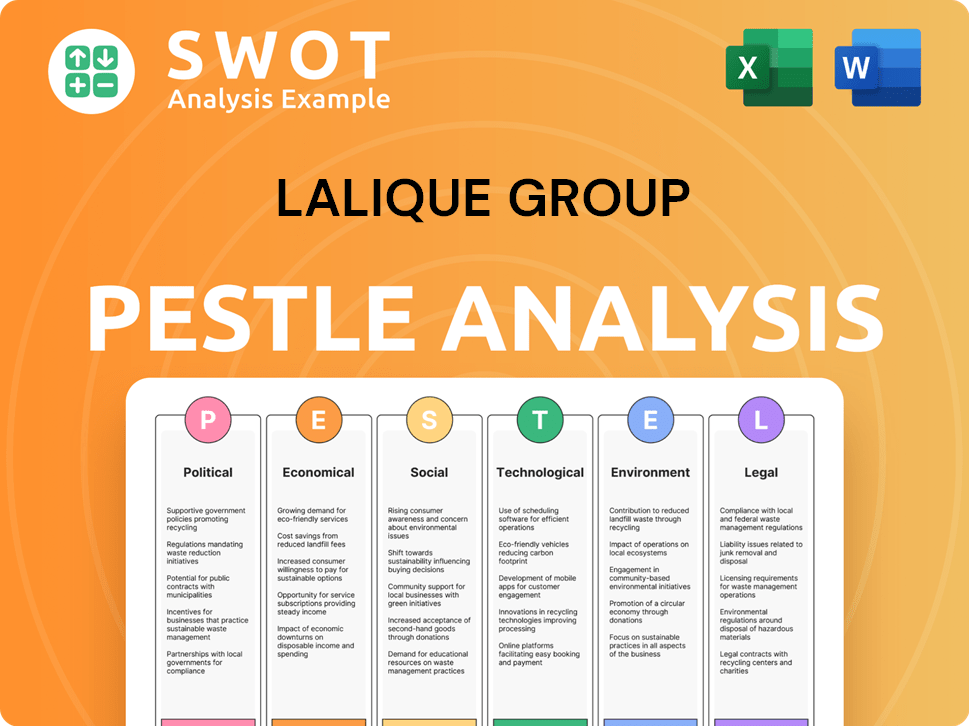
What are the key Milestones in Lalique Group history?
The Lalique Group's history is marked by significant milestones that have shaped its identity and influence in the luxury goods market. From its origins in the late 19th century to its current status, the Lalique company has navigated through various phases of growth, innovation, and adaptation, establishing a legacy of exquisite craftsmanship and artistic excellence. This journey includes pivotal moments that have defined the Lalique history and its evolution.
| Year | Milestone |
|---|---|
| Late 19th Century | René Lalique establishes himself as a leading jeweler, known for his innovative designs and use of materials. |
| Early 20th Century | Collaboration with Coty for perfume bottle design begins, transforming the perfume industry. |
| 1945 | René Lalique's death leads to a transition in leadership and strategic shifts. |
| Post-1945 | The company transitions from demi-crystal to lead crystal under Marc Lalique, expanding its product range. |
| Recent Years | The Lalique Group focuses on expanding its hospitality segment and strengthening its global distribution network. |
René Lalique pioneered the use of glass as a primary artistic medium, elevating it from a utilitarian material to a sculptural art form. His mastery of techniques like 'cire perdue' and the development of opalescent glass were industry firsts, setting new standards for artistic expression and craftsmanship.
René Lalique revolutionized glassmaking by transforming it into a medium for artistic expression, moving beyond its functional uses.
The company employed innovative techniques such as 'cire perdue' (lost-wax casting) and developed opalescent glass, setting new standards in the industry.
The collaboration with Coty for perfume bottles transformed the perfume industry, integrating artistic design with commercial products.
Lalique became a leader in Art Nouveau and Art Deco design, influencing artistic styles and setting trends in luxury goods.
The company expanded its product lines beyond jewelry and perfume bottles to include crystal sculptures, vases, and other luxury items.
The company has continuously worked to strengthen its global distribution network to reach a wider audience and increase sales.
The Lalique Group has faced numerous challenges, including disruptions from global economic shifts and changing consumer preferences. The luxury market's volatility has necessitated continuous innovation in product development and marketing strategies, as highlighted in a recent analysis of the Growth Strategy of Lalique Group.
The two World Wars significantly disrupted production and impacted international markets, posing major challenges to operations.
Economic downturns in the 20th century required strategic adaptations to maintain profitability and market presence.
Balancing artistic integrity and brand exclusivity with commercial pressures and expanding product lines has been a continuous challenge.
Transitions in leadership, such as after René Lalique's death, required adapting production methods and evolving the brand's aesthetic.
The luxury market faces challenges from global economic shifts and changing consumer preferences, requiring continuous innovation.
In 2023, the crystal segment saw a decrease in net sales, though overall net sales for the group increased by 1.6% to EUR 173.8 million, reflecting ongoing market challenges and strategic adaptations.
Lalique Group Business Model Canvas
- Complete 9-Block Business Model Canvas
- Effortlessly Communicate Your Business Strategy
- Investor-Ready BMC Format
- 100% Editable and Customizable
- Clear and Structured Layout
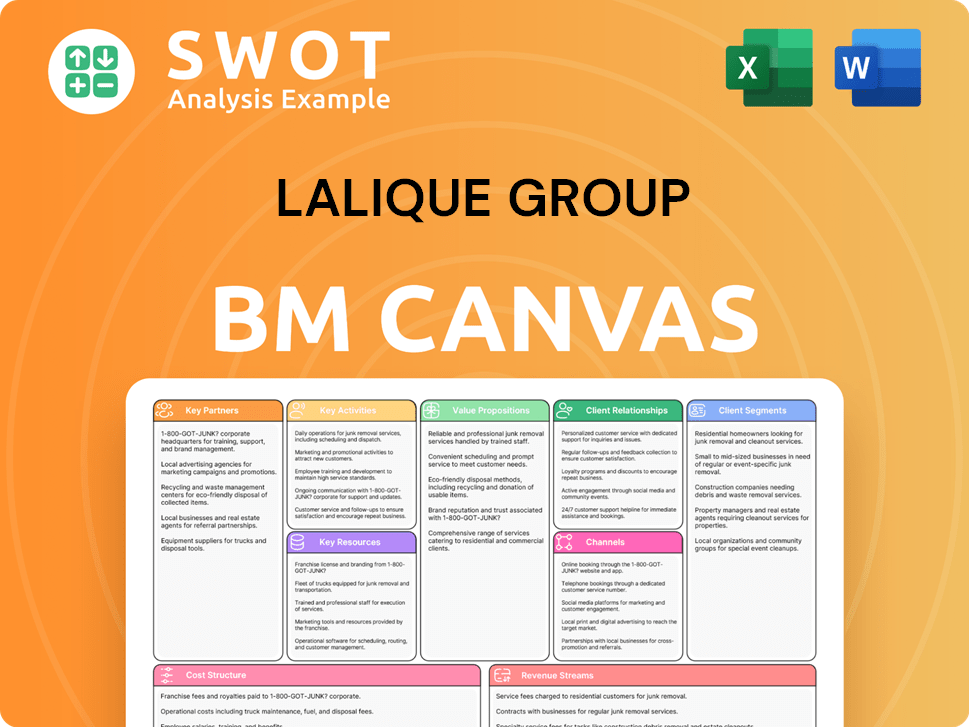
What is the Timeline of Key Events for Lalique Group?
The Lalique Group's journey is marked by pivotal moments, from René Lalique's jewelry workshop launch to its current status as a luxury conglomerate. The company's evolution showcases a blend of artistic innovation and strategic business decisions, solidifying its place in the luxury market. The company's history is a testament to its enduring legacy.
| Year | Key Event |
|---|---|
| 1888 | René Lalique establishes his jewelry workshop in Paris, marking the beginning of the Lalique legacy. |
| 1907 | René Lalique begins designing and producing perfume bottles, a significant step into the fragrance industry. |
| 1909 | The first glassworks opens in Combs-la-Ville, expanding the company's production capabilities. |
| 1921 | The Wingen-sur-Moder glassworks is constructed, becoming the sole manufacturing site for Lalique crystal. |
| 1925 | Lalique's Art Deco prominence is solidified through extensive exhibitions at the International Exhibition in Paris. |
| 1945 | Marc Lalique takes over after René's passing, shifting the focus to lead crystal. |
| 1977 | Marie-Claude Lalique expands the product range, continuing the brand's evolution. |
| 1994 | Art & Fragrance SA (now Lalique Group SA) is founded, later acquiring control of Lalique SA. |
| 2015 | Lalique Group AG lists its shares on the SIX Swiss Exchange. |
| 2023 | Lalique Group reports net sales of EUR 173.8 million, with a strategic focus on future growth. |
| 2024 | The company focuses on its 'Lalique 2025' strategy, emphasizing brand elevation and strategic market presence. |
The 'Lalique 2025' strategy is central to the company's future, focusing on brand elevation and global expansion. This includes strengthening the brand's presence in key luxury markets and enhancing its digital footprint. The strategy aims to drive sustainable growth and maintain market leadership in the luxury sector. The company is also focused on product innovation within its core crystal and fragrance businesses.
Lalique Group plans to diversify its luxury portfolio, particularly in hospitality and gastronomy. The hospitality segment showed significant growth in 2023. The company is also adapting to industry trends, such as the increasing demand for experiential luxury and sustainable practices. These efforts are crucial for capturing new market opportunities and ensuring long-term relevance.
In 2023, Lalique Group reported net sales of EUR 173.8 million, a 1.6% increase from the previous year, highlighting resilience. Analysts predict continued growth in the global luxury goods market. The company's strategic initiatives and brand strength position it well for sustained success. Continued focus on innovation and craftsmanship is expected.
Leadership consistently emphasizes upholding René Lalique's vision of artistic excellence and exceptional craftsmanship. This commitment ensures the company remains at the forefront of the luxury industry. The focus is on adapting to evolving consumer demands while preserving the brand's heritage. The goal is to maintain a strong brand identity and market position.
Lalique Group Porter's Five Forces Analysis
- Covers All 5 Competitive Forces in Detail
- Structured for Consultants, Students, and Founders
- 100% Editable in Microsoft Word & Excel
- Instant Digital Download – Use Immediately
- Compatible with Mac & PC – Fully Unlocked
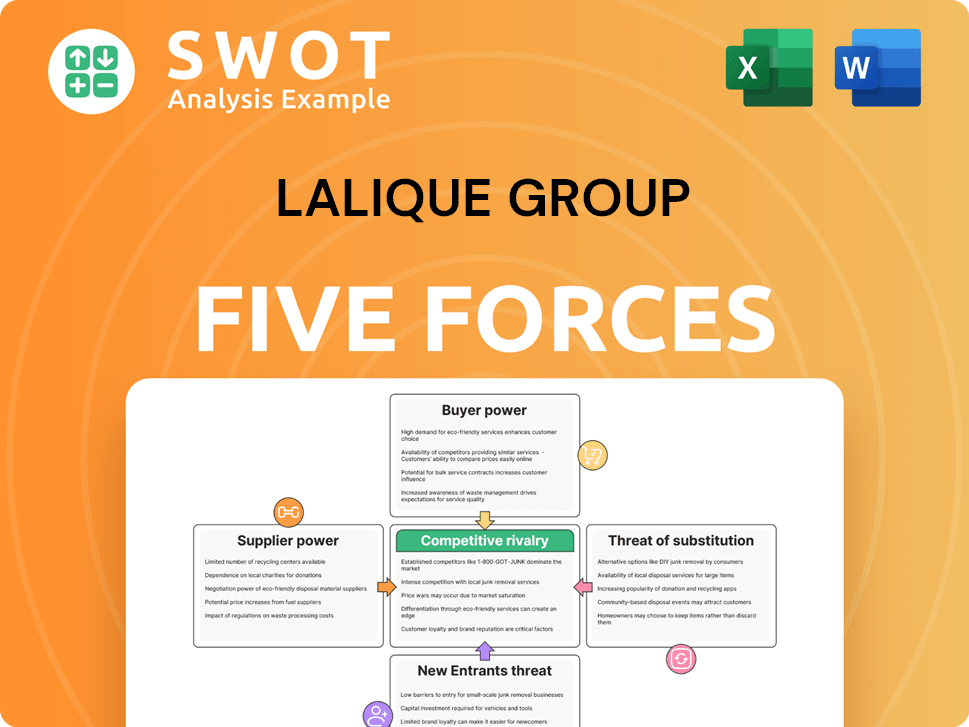
Related Blogs
- What is Competitive Landscape of Lalique Group Company?
- What is Growth Strategy and Future Prospects of Lalique Group Company?
- How Does Lalique Group Company Work?
- What is Sales and Marketing Strategy of Lalique Group Company?
- What is Brief History of Lalique Group Company?
- Who Owns Lalique Group Company?
- What is Customer Demographics and Target Market of Lalique Group Company?
Disclaimer
All information, articles, and product details provided on this website are for general informational and educational purposes only. We do not claim any ownership over, nor do we intend to infringe upon, any trademarks, copyrights, logos, brand names, or other intellectual property mentioned or depicted on this site. Such intellectual property remains the property of its respective owners, and any references here are made solely for identification or informational purposes, without implying any affiliation, endorsement, or partnership.
We make no representations or warranties, express or implied, regarding the accuracy, completeness, or suitability of any content or products presented. Nothing on this website should be construed as legal, tax, investment, financial, medical, or other professional advice. In addition, no part of this site—including articles or product references—constitutes a solicitation, recommendation, endorsement, advertisement, or offer to buy or sell any securities, franchises, or other financial instruments, particularly in jurisdictions where such activity would be unlawful.
All content is of a general nature and may not address the specific circumstances of any individual or entity. It is not a substitute for professional advice or services. Any actions you take based on the information provided here are strictly at your own risk. You accept full responsibility for any decisions or outcomes arising from your use of this website and agree to release us from any liability in connection with your use of, or reliance upon, the content or products found herein.